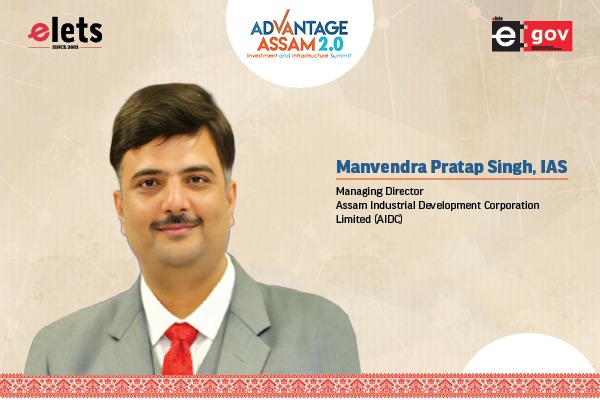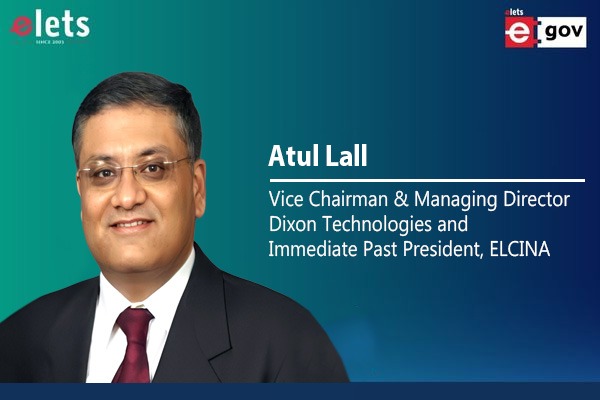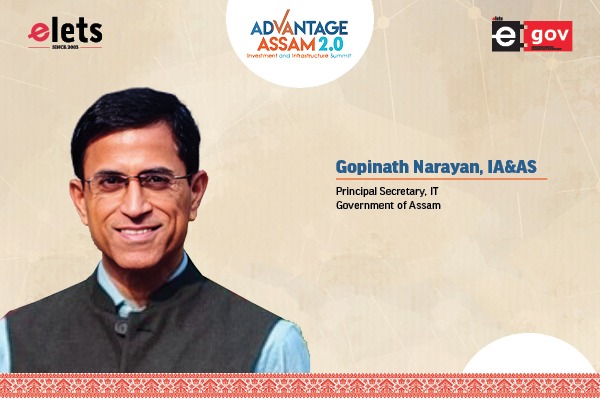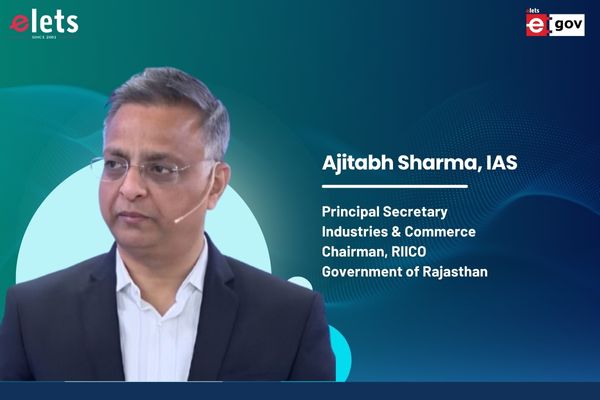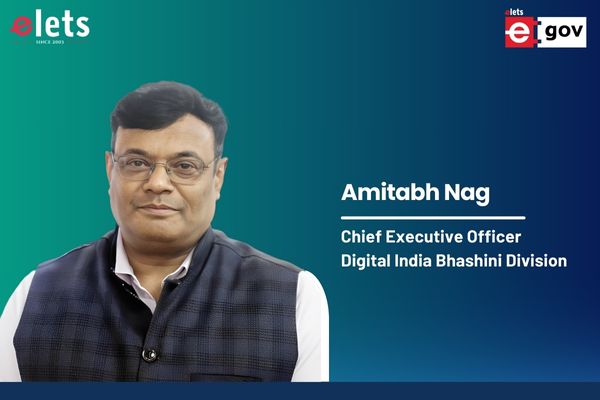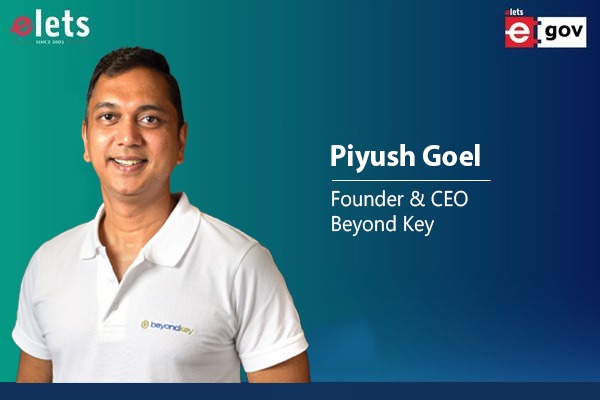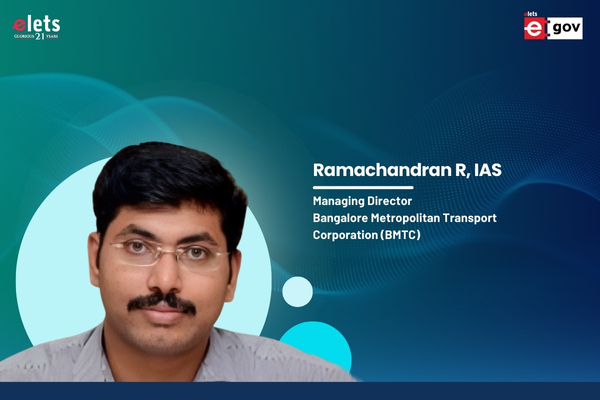
Ramachandran R, IAS, Managing Director of Bengaluru Metropolitan Transport Corporation (BMTC), unveils a visionary roadmap for the city’s public transport in an exclusive interaction with Krishna Mishra of Elets News Network (ENN). From real-time bus tracking to electric fleets, BMTC is steering Bengaluru towards a future where technology, sustainability, and passenger convenience converge. Edited Excerpts:
How are you planning to leverage technology to enhance the operational efficiencies of BMTC and streamline its overall operations?

The use of technology has been prevalent for the past 20 years. A significant development is the launch of the BMTC app, which has already seen extensive adoption. The BMTC app provides real-time bus locations to and from various destinations. For example, if you are travelling by metro bus, you can use the app to see how many buses will arrive at the bus stop in the next few minutes and where the next bus is located. The app also offers the expected time of arrival for the next bus.

This technological advancement allows metro travellers to plan their journeys efficiently, reducing their reliance on private transport options like Ola, Uber, and auto-rickshaws. In this way, the BMTC app enhances the welfare of passengers by offering convenience and real-time information.

Additionally, the app’s real-time location data helps identify bus crowding, known as bus bunching, where multiple buses leave simultaneously. This issue can be mitigated by leveraging GPS data, improving the overall bus service.

Furthermore, to enhance passenger safety, BMTC has installed three cameras in each bus—one in the front, one in the rear, and one inside the cabin. These cameras continuously record, helping reduce crime, particularly against women, and other issues like pickpocketing. For instance, the recent Rameshwar Cafe Blast incident was identified using footage from these CCTV cameras. The recorded data is stored for a maximum of 7-8 days, ensuring a safer travel experience for all passengers.
We are working to enhance data longevity by increasing data storage capacity. Currently, we use a cloud platform, but we are exploring options to expand this further. If corporate social responsibility initiatives come up to support BMTC, we could elevate our efforts to higher levels.
Our experts have studied the technologies used in cities like London, aiming to implement similar strategies. However, our city’s crowding patterns and requirements differ significantly from those of London. The comprehensive mobility plan for BMTC demands a minimum of 11,000 buses by 2024, compared to our current fleet of 6,100 buses. Of these, 85 buses are kept aside for repairs and emergency use, highlighting a 50% shortage. This shortage affects our ability to extend services from the current 15-20 kilometre radius to 25 kilometres from the city centre.
The movement of lower and middle-income groups into the city centre is increasing daily, with many commuting from neighbouring Tier 2 cities and towns. Thus, technology is crucial to improve bus availability. Currently, bus occupancy is around 40-45% during normal times and 60-70% during peak hours. However, after introducing the Shakti Scheme, buses are now fully occupied, with 80-85 passengers per bus. There have been complaints of buses not stopping at bus stops because they are already full, indicating a need for more buses
Regarding technology, we are transitioning from cloud storage to Karnataka State Data Centre (KSDC) servers to enhance efficiency. The BMTC app benefits our passengers and is part of this technological shift. We also have CCTV cameras in buses, enhancing the safety of women and passengers.
Digital passes are available, eliminating the need to visit depots for monthly, daily, or weekly passes. Student passes can be applied for online, and physical passes can be collected from counters. Online approvals are in place, and online payments are also an option, although currently underutilised, with only 1-2% adoption. We have implemented QR codes in buses for ticketing, but this method has not gained significant traction. We encourage conductors to promote QR code-based UPI payments to alleviate congestion in the cabins and ensure timely ticket issuance.
Additionally, the Southwest Private Bus Transport Association in Mangaluru is planning to launch online appbased ticketing, a system BMTC already has but needs to popularise further. We aim to reduce conductor reluctance through training, motivation, and appreciation, thereby increasing the adoption of QR-based payments and other technology-based interventions that enhance efficiency.
Are there plans to use data analytics to study ridership patterns and improve fleet management? You mentioned addressing concerns such as bunching and overcrowding; could you provide more details on our specific challenges in this area?
IIT Roorkee is conducting a pilot project to study data and analytics, primarily focusing on fleet optimisation, scheduling, and rescheduling. With the Shakti Scheme already in place, we are not planning for additional ridership since our buses are operating at full capacity. Therefore, increasing the number of buses is our priority.
This pilot project involves German partners, the GS Foundation, and IIT Roorkee. They aim to complete the study by the end of November. The outcome will guide us in optimising schedules, as our current manual scheduling process will be improved based on ridership data, enhancing the efficiency of our operations.
This analytics-driven approach will help us effectively utilize available resources, ensuring more buses are on the roads at proper intervals. This will facilitate timely transportation for passengers, significantly improving the overall service.
How is your organisation leveraging technology to enhance profitability, and what are your future plans regarding financial stability and viability?
In the past, we used different coloured paper tickets during our college days, but now most STUs, including the Bengaluru Transport Corporation, have transitioned to electronic ticketing machines (ETMs). These ETMs are now connected to servers, unlike before. The ETMs also have SIM cards that allow for real-time ticket issuance tracking.
We use a distributed architecture with depot servers and a central server at the Karnataka State Data Centre. This setup ensures that operations continue smoothly even if there is a network issue at the depot level. If connectivity to the central server is lost, the local depot server is a backup to prevent operational disruptions.
Going forward, we plan to implement the National Common Mobility Card (NCMC) system. We have sought funds from the Ministry of Road Transport and Highways (MoRTH) to implement a fare collection system. If approved, we will introduce mobile ticketing, smart card-based ticketing, and ETM issuance. Our ETM machines are capable of integrating with the NCMC system, allowing metro cards to be used in the metro for traveling on BMTC buses as well as facilitating seamless multimodal connectivity.
So, what is the current status of collaboration between BMTC and BMRCL?
The biggest development is our metro feeder buses, which we operate in collaboration with BMRCL. We currently operate around 190 metro feeder buses, and as new stations are inaugurated, we extend our connections to those stations as well.
We have placed QR codes at metro stations that can be scanned using the BMTC app, providing direct access to realtime information. Additionally, we have installed 500 Public Information System (PIS) boards across the city at bus stops. These boards display real-time information, including the bus’s estimated time of arrival (ETA).
We have initiated this system at 500 of the approximately 6,000 bus stops. By scanning the QR codes or using the BMTC app, passengers can access the same real-time information displayed on the PIS boards. This system ensures that passengers are well-informed about the next bus’s ETA, improving our services’ overall convenience and efficiency
As QR codes are being stationed at different metro premises. Do we have a provision for taking tickets through those QR codes?
No, these QR codes currently only provide information about bus locations, network services, metro services, their locations, and timings. However, once passengers enter the metro feeder bus, they can scan the QR code and pay for their ticket. Due to crowding issues, this system hasn’t been fully implemented yet and needs further intervention.
We believe that promoting QR code-based ticketing is essential. We should encourage its use for those who are more interested in paying for their tickets this way. To incentivise this, we could recognise and reward the conductors achieving the highest QR-based ticket sales each month. This recognition and prize money could send a positive message and motivate conductors to promote QR-based ticketing.
Over the last six months, we’ve collected data on QR codebased ticketing. By gradually implementing positive conditioning strategies, we aim to increase its adoption and improve the overall efficiency of our ticketing system.
What are the future plans of BMTC?
One of our major initiatives is the implementation of the National Common Mobility Card (NCMC). We envision moving beyond even the need for physical cards. Almost everyone carries a mobile phone, so we aim to facilitate mobile-based payments. We aim to eliminate the need for any physical cards, allowing people to walk in and out of transport systems seamlessly. Similar to how FASTag works at toll plazas, GPS-based ticketing systems automatically calculate fares based on where passengers board and alight from the bus, deducting the fare from their account without human intervention.
Technology and Electrification
Another significant focus is on electric buses. We are transitioning to advanced battery technologies, such as lithium-ion batteries, which offer greater storage capacity and less weight. This transition is crucial, although the cost of electric buses remains high, around two crores each. We aim to optimise using different bus sizes based on route demand. We plan to use 12-meter buses for crowded routes, while smaller buses will be used for routes with lower occupancy to ensure optimal utilisation.
Increasing public transport usage is vital for reducing the number of vehicles on the road. The introduction of the Shakti Scheme has led to a 15-20% increase in ridership, particularly among women who now prefer public transport over their two-wheelers. We are also considering reimplementing exclusive bus priority lanes, similar to the BRTS, to enhance the efficiency of our services.
Technology Upgrades and Efficiency
We are committed to upgrading our technology infrastructure. This includes shifting to online, ledger-based, and accrual-based accounting systems and moving away from traditional methods. We are exploring various technology interventions and innovative ideas from startups to increase operational efficiency.
Expansion of Electric Buses
Currently, we operate 690 electric buses, including 300 nonAC and 390 AC buses. We plan to add 320 AC buses for premium airport routes. Another 120 buses are in the tendering stage, with 76 buses already approved by the Urban Development Department (UDD). By June 2025, we aim to have approximately 1,500 electric buses on the road, doubling our current fleet.
These initiatives highlight our commitment to serving the people of Bengaluru more efficiently and dynamically, meeting the future needs of urban transportation.
Be a part of Elets Collaborative Initiatives. Join Us for Upcoming Events and explore business opportunities. Like us on Facebook , connect with us on LinkedIn and follow us on Twitter, Instagram.
"Exciting news! Elets technomedia is now on WhatsApp Channels Subscribe today by clicking the link and stay updated with the latest insights!" Click here!




